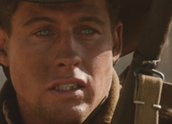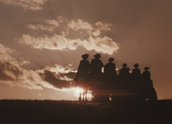


The Lighthorsemen (1987)
Synopsis
It is the end of the third year of the Great War. The Australian forces are fighting in France and the Middle East, more than two years after the landings at Gallipoli. In Egypt and Palestine, the young soldiers of the 4th Australian Light Horse Brigade are anxious to prove themselves, but frustrated by inaction. The Australian commander of the Desert Mounted Corps, Lieutenant-General Sir Harry Chauvel, is stymied by his British superiors, who have failed to take the Turkish stronghold at Gaza. The Australian Light Horse patrol the desert, sabotaging the enemy’s train lines and skirmishing with their Bedouin allies. The Light Horse men fight as four-man units, becoming very close-knit.
When trooper Frank (Gary Sweet) is wounded by a Bedouin bullet, his replacement is a raw recruit, Dave (Peter Phelps). He joins three seasoned soldiers, Tas (John Walton), Chiller (Tim McKenzie) and an Irishman called Scotty (Jon Blake). Dave overcomes their hostility by proving he can ride well and shoot straight, but he is completely unnerved by his first action, an ambush of a Turkish mounted column. He is unable to shoot, especially at men who are retreating. Dave is slightly injured during an attack by a German aeroplane, but he saves the four horses from his unit. In hospital, he falls in love with a nurse, Anne (Sigrid Thornton), confiding in her that he fears he is a coward. Back in the unit, his mates are concerned that he is still unable to fire a shot in anger. Reluctantly, Dave transfers to an ambulance unit.
With the arrival of General Allenby as the new British commander, Lt-Gen Chauvel (Bill Kerr) begins a more offensive role against the Turks. The aim is to take Beersheba, as a prelude to attacking Gaza. The problem is water: the Australian horses will have to go 30 hours without water, and if the attack fails, the horses may die in the desert. A young British intelligence officer hatches a plan to deceive the enemy. Major Meinertzhagen (Anthony Andrews) concocts a fictitious plan of attack to convince the Turks that the attack on Beersheba is only a diversion. Instead, 60,000 men attack the small town, beginning with a heavy British artillery barrage early on 31 October 1917. By the end of the day, the attack has had some success, but they are running out of time. The town and its wells must be taken, to get the horses to water.
Chauvel agrees to a desperate plan: two regiments of 4th Light Horse Bde, the 4th and 12th, will charge across three kilometres of open ground in a frontal attack on Turkish trenches, against artillery and machine guns. The attack begins in late afternoon, with 500 horses charging at the enemy positions. Against all odds, the attack is successful. The Australians take the town with few casualties. Tas is killed during the charge and Dave is badly wounded, trying to protect Chiller from a grenade. At El Arish military hospital, Dave is reunited with Anne.
Curator’s notes
The story of the charge of the 4th Brigade of the Australian Light Horse at Beersheba was well known to the generations of Australians who had grown up immediately after the two world wars, partly because it had been filmed twice. Official war photographer Frank Hurley was on the spot in Palestine shortly after the charge in 1917, and he persuaded the Light Horse to restage the charge, so that he could film it. That footage is lost, but 20 years later, Charles Chauvel made Forty Thousand Horsemen (1940), a feature film with Chips Rafferty. He recreated the Middle East on sand dunes near Sydney and on the western plains of NSW, near Dubbo. Charles Chauvel had a personal interest in the story, as the commander of the Desert Mounted Corps, made up of Australian and New Zealand units, was his uncle, Sir Harry Chauvel. The film was a substantial hit in 1940, during the dark days of the Second World War.
By the mid-1980s, 45 years after Chauvel’s film, the charge had faded in the Australian memory. The campaign at Gallipoli had risen higher, especially after the release of Peter Weir’s film Gallipoli in 1981. There are strong similarities between the two films, but also significant differences that may help to explain the comparative failure of The Lighthorsemen. Peter Weir’s film dramatises the events of Gallipoli in a way that flattered the growing sense of nationalism around that campaign in Australia; The Lighthorsemen is similarly complimentary to an Australian sense of pride, and both films end with a shattering climax. The most significant difference might be that Gallipoli (1981) is about a glorious failure, and The Lighthorsemen is about a glorious victory. According to one popular theory about Australian culture, we prefer defeats, or at least we did then. By this argument, the movie about Phar Lap (1983) would have been a flop if the horse had lived.
It is not hard to question this logic. Just before The Lighthorsemen was made, the Australian production company Hoyts Edgley, which developed it, spent about the same amount of money to make Burke & Wills (1985), starring Jack Thompson and the imported English actor Nigel Havers. Indeed, the decision to back Burke & Wills effectively put The Lighthorsemen on hold. Burke & Wills was also the story of an epic failure, but it did not succeed at the box office. Thus, it would seem that the reasons that The Lighthorsemen failed are more complex and subjective.
David Stratton, in his book The Avocado Plantation (1990, Pan Macmillan) lays the blame firmly on the screenplay ‘which is pedestrian and uninvolving and which includes an extraneous love affair between the hero, Dave (Peter Phelps) and a nurse played by Sigrid Thornton’. Stratton continues: ‘the central characters in the film never come alive the way Archy and Frank did in ??Gallipoli??’. That may be true, but worse films than The Lighthorsemen made a lot more money at the Australian box office in the decade before it.
The logic behind The Lighthorsemen as a film venture appeared to be sound. It was a reasonably well known and glorious event in Australian history, it had an enormously exciting climax, the Australian public had loved Gallipoli (1981), and The Lighthorsemen had another essential attraction – great numbers of horses. In a country founded on agriculture and gambling, the horse holds a strong place in our national folklore, in song, poem and story. In terms of ‘horse operas’, the charge on Beersheba seemed hard to beat.
The film had been in development for at least five years before it went into production in September 1987. Ian Jones, a former writer at Crawford Productions (which produced Homicide and The Sullivans – see The Sullivans – On the Brink of War, 1976) had also written popular mini-series (such as Against the Wind, 1978, and The Last Outlaw, 1980) and a feature film (the Mick Jagger version of Ned Kelly, 1970). He had spent 15 years researching the story of the charge at Beersheba. He was originally slated to direct his own script, with Gil Brealey as producer.
After the film was put on hold at Hoyts Edgley, Simon Wincer (with whom Jones had worked before) showed the script to executives at the venerable RKO studio in Hollywood. They bought the rights for $6 million, a record price for an Australian film at the time. The Australian producer Antony I Ginnane completed the financing, taking the budget to $10.5 million. The film received support from the Australian Film Commission, Film Victoria and the South Australian Film Corporation. One major change was that RKO insisted that Simon Wincer take over as director, rather than Jones. Wincer had a track record as director of Phar Lap (1983), and co-producer of The Man from Snowy River (1982). Jones and Wincer became joint producers.
The logistics of the film were enormous. Hundreds of horses and riders had to be trained for the extremely exacting stunts. The shoot took place near Hawker in South Australia, but it was not smooth. The Egyptian village and the Beersheba set were severely damaged by storms and had to be rebuilt, and the production lost nine days to weather. The re-creations of uniform and kit used by the Australian Light Horse in 1917 are extremely accurate, down to the bridles and reins on the horses. The horse action was also carefully planned, and the film boasts an end title saying that no horses were injured or killed in its production, a remarkable achievement given the number involved.
As a re-creation of the charge at Beersheba, the film is thrilling and completely successful. The last 20 minutes are superbly put together and historically accurate, which is perhaps even more remarkable. That is probably due to the persistence of Ian Jones, who had researched the material to the last detail. For anyone interested in Australian military history, there is much to enjoy in the rest of the film, not just the climax. The depictions of Australian military life in Egypt, the re-creation of the Australian camps, the dramatisation of the chain of events, including depictions of which commanders were in charge, using their real names, make this one of the most accurate films about the Australian participation in the First World War. Even the stories of some of the central characters, including the young recruit played by Peter Phelps, who falls in love with the Australian nurse played by Sigrid Thornton, are based on true stories.
Unfortunately, accuracy is not the same as dramatic impact. It’s fair to say that the four Australian soldiers at the centre of the action lack dimension as characters. That may be the film’s fatal flaw. Gallipoli (1981) had the benefit of a young actor who was on the way to enormous popularity, in Mel Gibson. The Lighthorsemen lacks the same star power. Most of the energy is in re-creation, rather than dramatisation.
Few Australian films have a more thrilling finale than The Lighthorsemen. Dean Semler’s camerawork throughout the film is exemplary, but the final charge is one of his finest efforts. This may be the film that convinced Kevin Costner to hire him to shoot Dances with Wolves (1990), for which Semler won an Oscar. In the end, The Lighthorsemen failed to deliver an emotional charge to match its charging horses. That is the essential point of difference with Gallipoli (1981), in which the climactic scenes are shattering. The Lighthorsemen works well as history, but less well as drama.
The Lighthorsemen was released in Australian cinemas on 10 September 1987. It won AFI Awards in 1988 for Best Original Music Score (Mario Millo) and Sound (Lloyd Carrick, Craig Carter, Peter Burgess, James Currie, Phil Heywood and Peter D Wood) and was nominated for Cinematography (Dean Semler).
- Overview
- Curator’s notes
- Video 3 clips
- Principal credits
- Find a copy
- Make a comment
- Map
- Add your review



